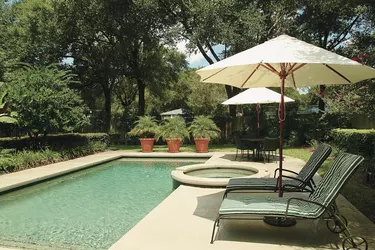
Monthly inground pool costs vary. Your expenses will be influenced by the size of your pool, how often you use it, the type of liner, your habits and any optional features that you add. The larger the pool, the larger your monthly expenses. Location is also a factor. If you're in a colder area, you'll pay more to open and close your pool as well as to heat it.
Utilities
Video of the Day
One of the most obvious costs is the increase in your utility bills. An Olympic-size inground pool requires an Olympic-sized amount of water to fill it. In addition to the water, you'll pay for the electricity for the pool pump, heater, lighting and any other features that use power, costing around $100 a month. Installing a solar pool heater increases your upfront expenses, but can bring down your monthly electrical costs.
Video of the Day
Maintenance
Some of your monthly costs will vary. For example, vinyl pool liners tear more easily than fiberglass liners, so you may find yourself replacing them more frequently. You can save hundreds of dollars by using an inground pool cover, since your cleaning costs will be lower. Other items that may need to be replaced over time are any electric pool appliances like pumps or heaters. If you know your pump is struggling, price alternatives and do some research. Replacing a failing pump or heater can save you money. An appliance that isn't working well can use more electricity, since it takes longer to do the job properly.
Chemicals
The size of your pool has a big influence on the cost for chemicals, such as chlorine, each month. The warmer the climate, the faster algae tends to grow if the pool isn't treated. According to Dave Cook, president of Supplies Company Pool Corp., the typical cost for pool chemicals is $500 to $800 a year. If you live in a colder climate and need to open the pool at the start of the season and close it in the fall, you can pay another $500 or more. Once way to bring down your monthly pool chemical bill is to install a fiberglass pool liner. Since it's more algae-resistant than other types of liners, you may be able to reduce the amount you spend on algae-killing chemicals.
Compare Pump Costs
On of the largest ongoing costs can the electricity used by your pool's pump, so the pump you choose can play a major role in your monthly cost to maintain the pool. A 2-speed and variable speed pump and filter system gives you the option of varying the speed depending on your needs. You can run it on low during the summer to constantly filter your water and keep your pool clean. Since it's only on high speed occasionally, like when you're vacuuming, you'll use less power. The 2-speed pump uses an estimated $30 to $50 per month of electricity, including salt for salt water pools. A 1-speed pump needs to run at high speed all the time or work on intervals, allowing dirt and algae to build up between intervals.